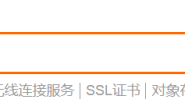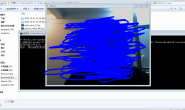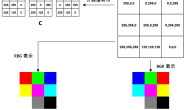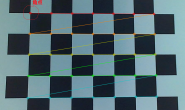本文作者:iwande
1.为什么要介绍这个方法?
2018年的时候,D.DeTone等人发表了Self-Supervised Interest Point Detection and Description,提出了一种特征提取SuperPoint的方法。他们在训练Superpoint的时候,构造了一组人工合成数据集Synthetic Shapes dataset(这个数据集能提供角点的坐标作为groundtruth),因此也可以测试superpoint最后的效果。 所以说,Synthetic Shapes dataset它最大的优点,就是简单,而且能够提供特征点的groundtruth,这对于检测特征点十分重要! 非常不幸的是,作者不打算提供Synthetic Shapes dataset,所以,把作者相关的代码提取出来就显得十分有意义。
2.Synthetic Shapes dataset的生成
打开官方链接,找到superpoint/datasets/synthetic_dataset.py 这个路径,这个py脚本就是用来生成Synthetic Shapes dataset的!! 第一步,生成图片背景,在52行或者82行:
def generate_background(size=(960, 1280), nb_blobs=100, min_rad_ratio=0.01,
max_rad_ratio=0.05, min_kernel_size=50, max_kernel_size=300):
""" Generate a customized background image
Parameters:
size: size of the image
nb_blobs: number of circles to draw
min_rad_ratio: the radius of blobs is at least min_rad_size * max(size)
max_rad_ratio: the radius of blobs is at most max_rad_size * max(size)
min_kernel_size: minimal size of the kernel
max_kernel_size: maximal size of the kernel
"""
def generate_custom_background(size, background_color, nb_blobs=3000,
kernel_boundaries=(50, 100)):
""" Generate a customized background to fill the shapes
Parameters:
background_color: average color of the background image
nb_blobs: number of circles to draw
kernel_boundaries: interval of the possible sizes of the kernel
"""
第二步,画线,得到特征点的坐标(138行):
def draw_lines(img, nb_lines=10):
""" Draw random lines and output the positions of the endpoints
Parameters:
nb_lines: maximal number of lines
"""
...
return points
第三步,你也可以画多边形(166行或227行):
def draw_polygon(img, max_sides=8):
""" Draw a polygon with a random number of corners
and return the corner points
Parameters:
max_sides: maximal number of sides + 1
"""
...
return points
def draw_multiple_polygons(img, max_sides=8, nb_polygons=30, **extra):
""" Draw multiple polygons with a random number of corners
and return the corner points
Parameters:
max_sides: maximal number of sides + 1
nb_polygons: maximal number of polygons
"""
...
return points
第四步,你可以画星星(334行):
def draw_star(img, nb_branches=6):
""" Draw a star and output the interest points
Parameters:
nb_branches: number of branches of the star
"""
...
return points
画椭圆(304行):
def draw_ellipses(img, nb_ellipses=20):
""" Draw several ellipses
Parameters:
nb_ellipses: maximal number of ellipses
"""
画棋盘格(362行):
def draw_checkerboard(img, max_rows=7, max_cols=7, transform_params=(0.05, 0.15)):
""" Draw a checkerboard and output the interest points
Parameters:
max_rows: maximal number of rows + 1
max_cols: maximal number of cols + 1
transform_params: set the range of the parameters of the transformations"""
...
return points
画立方体(596行):
def draw_cube(img, min_size_ratio=0.2, min_angle_rot=math.pi / 10,
scale_interval=(0.4, 0.6), trans_interval=(0.5, 0.2)):
""" Draw a 2D projection of a cube and output the corners that are visible
Parameters:
min_size_ratio: min(img.shape) * min_size_ratio is the smallest achievable
cube side size
min_angle_rot: minimal angle of rotation
scale_interval: the scale is between scale_interval[0] and
scale_interval[0]+scale_interval[1]
trans_interval: the translation is between img.shape*trans_interval[0] and
img.shape*(trans_interval[0] + trans_interval[1])
"""
...
return points
第五步,你还可以给图片增加颗粒感(40行):
def add_salt_and_pepper(img):
""" Add salt and pepper noise to an image """
noise = np.zeros((img.shape[0], img.shape[1]), dtype=np.uint8)
cv.randu(noise, 0, 255)
black = noise < 30
white = noise > 225
img[white > 0] = 255
img[black > 0] = 0
cv.blur(img, (5, 5), img)
return np.empty((0, 2), dtype=np.int)
或者gauss噪声(104行或683行):
def final_blur(img, kernel_size=(5, 5)):
""" Apply a final Gaussian blur to the image
Parameters:
kernel_size: size of the kernel
"""
cv.GaussianBlur(img, kernel_size, 0, img)
def gaussian_noise(img):
""" Apply random noise to the image """
cv.randu(img, 0, 255)
return np.empty((0, 2), dtype=np.int)







